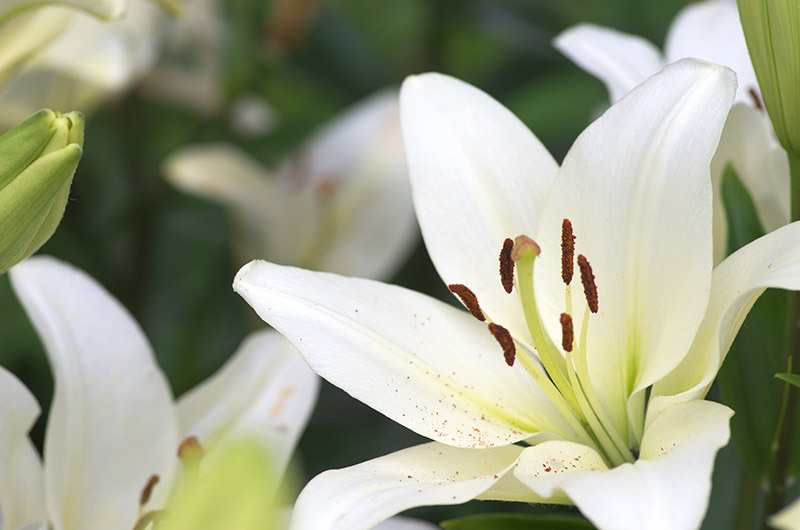Soil, Sun, and Hydrangeas: Creating the Perfect Growing Environment
Hydrangeas are beloved garden shrubs cherished for their stunning blooms, vibrant foliage, and ability to transform any landscape. However, cultivating hydrangeas successfully requires an understanding of their core needs--especially the interplay between soil, sunlight, and environmental conditions. In this comprehensive guide, we'll dive deep into the essentials of creating the perfect growing environment for hydrangeas--ensuring your garden bursts with color, season after season.
Why Environment Matters for Hydrangeas
Hydrangeas are not a one-size-fits-all plant; their flourishing depends on careful attention to soil, sunlight, water, and placement. Understanding and optimizing these factors will ensure your hydrangeas remain healthy and produce spectacular blooms.
- Soil type affects bloom color and plant vigor.
- Proper sunlight ensures lush foliage and abundant flowers.
- Consistent moisture and good drainage prevent disease.

Understanding Hydrangea Types and Their Requirements
Before tailoring the environment for your hydrangeas, it's essential to know which variety you have, as different hydrangea species often require distinct care:
- Hydrangea macrophylla (Bigleaf Hydrangea): Known for its color-shifting blooms, influenced by soil pH.
- Hydrangea paniculata (Panicle Hydrangea): Sun-tolerant with cone-shaped flowers.
- Hydrangea arborescens (Smooth Hydrangea): Prefers partial shade; bears large, round flower heads.
- Hydrangea quercifolia (Oakleaf Hydrangea): Thrives in shadier, well-drained areas; admired for striking foliage.
Knowing your hydrangea's type will guide your soil amendment and sunlight optimization strategies.
Choosing the Best Soil for Hydrangeas
The Essentials of Great Hydrangea Soil
Soil quality is perhaps the most critical factor for hydrangea health. Hydrangeas thrive in soil that is:
- Rich in organic matter
- Well-draining but moisture-retentive
- Loamy with a slightly acidic to neutral pH (5.2-6.2 for most varieties)
Test your soil before planting to determine its pH and organic matter content. Home soil test kits are readily available and offer quick, actionable results.
How to Amend Soil for Hydrangeas
If your native garden soil isn't ideal for hydrangeas, don't worry. There are easy ways to improve it:
- Mix in compost or well-rotted manure to boost nutrients and moisture retention.
- Add peat moss to increase acidity if needed.
- Use pine bark mulch to regulate moisture levels and further acidify the soil.
- Improve drainage by incorporating perlite or coarse sand if you have heavy clay.
Well-prepared soil not only nourishes hydrangeas but also makes them more resilient to weather swings and disease.
Controlling Hydrangea Bloom Color With Soil pH
One of the most fascinating aspects of some hydrangea varieties, especially Hydrangea macrophylla, is their flower color's sensitivity to soil pH:
- Acidic soil (pH below 6): Blue blooms
- Alkaline soil (pH above 7): Pink blooms
You can alter your hydrangea's color by amending the soil:
- To encourage blue flowers, add aluminum sulfate or sulfur to acidify the soil.
- To produce pink flowers, mix in lime to increase alkalinity.
Keep in mind, color changes are typically only possible with certain bigleaf and mountain hydrangeas. Other types, like panicle or oakleaf hydrangeas, stay true to their natural color, regardless of soil pH.
Sunlight: Finding the Sweet Spot for Your Hydrangeas
How Much Sun Do Hydrangeas Need?
The optimal amount of sunlight depends on the type of hydrangea. As a general rule:
- Morning sun and afternoon shade are ideal for most hydrangeas.
- Too much direct sun can scorch leaves and reduce flower production.
- Too little light can lead to leggy growth and few blooms.
Hydrangea Sunlight Needs by Variety
- Bigleaf and mountain hydrangeas: Prefer partial shade; best with sun in the morning and shade in the afternoon, especially in hot regions.
- Panicle hydrangeas: More sun-tolerant; thrive in full sun or partial shade.
- Oakleaf hydrangeas: Do well in dappled or partial shade but can withstand more sun in cooler climates.
- Smooth hydrangeas: Like morning sun/afternoon shade, especially in warmer areas.
Hydrangea care often means adjusting sun exposure as needed. Observe your plant for signs of leaf scorch or dull blooms and adjust its placement or provide shade as necessary.
How to Provide Shade for Hydrangeas
If your yard is particularly sunny, you can:
- Plant hydrangeas near taller shrubs or trees that offer filtered light.
- Use shade cloths during extreme heatwaves.
- Position them on the east or north side of buildings for natural afternoon shade.
Watering and Moisture--Keeping Hydrangeas Happy
How Much Water Do Hydrangeas Need?
Hydrangeas have 'hydra' in their name for a reason--they thrive on moisture! However, consistent, deep watering is more effective than frequent, shallow drinks. Here are a few watering tips:
- Water deeply once or twice a week; increase during hot, dry spells.
- Mulch with organic materials to retain moisture and regulate soil temperature.
- Ensure good drainage to avoid root rot--hydrangeas dislike soggy conditions.
Check the soil regularly by sticking your finger a couple of inches deep; water when the topsoil feels dry, but the subsoil remains moist.
Signs of Water Stress in Hydrangeas
- Wilting leaves during the day--though if they recover by evening, they're not actually thirsty.
- Leaf scorch or brown edges signal prolonged drought.
- Yellowing or stunted growth may indicate overly wet or poorly drained soil.
The Importance of Mulching
Applying mulch around your hydrangeas provides several benefits:
- Keeps soil consistently moist and cool
- Suppresses weeds
- Adds organic matter to the soil as it breaks down
- Prevents soil erosion and temperature swings
Opt for organic mulches like bark, pine needles, or compost, and apply a 2-3 inch layer around the base of your hydrangeas, avoiding direct contact with stems to prevent rot.
Fertilizing Hydrangeas: Tips for Vivid Blooms
Proper fertilization encourages healthy growth and flower production. Use a balanced, slow-release fertilizer in spring as new growth emerges:
- For lush foliage and robust growth, choose a fertilizer with a slightly higher nitrogen content.
- If you want to emphasize flowering, opt for a blend formulated for blooms, with more phosphorus.
- Avoid over-fertilizing--excess nitrogen may boost leaves at the expense of flowers.
Always water thoroughly after applying fertilizer to hydrate roots and prevent burning.
Site Selection and Planting for Long-Term Success
Even with ideal soil and sunlight, the location of your hydrangeas is paramount. Consider these tips for planting hydrangeas in the perfect spot:
- Choose locations with shelter from strong winds and extreme sun.
- Leave space for air circulation to reduce the risk of fungal disease.
- Plant at the same soil level as the nursery pot, not deeper--this prevents rot.
Incorporate organic material into the planting hole and water thoroughly after setting your hydrangea in place. This gives the roots a healthy head start.
Companion Planting and Landscape Design With Hydrangeas
Hydrangeas offer versatile beauty in the landscape and pair well with other shade-loving plants, such as:
- Hostas
- Astilbes
- Ferns
- Heucheras (coral bells)
These companions provide a tapestry of texture, seasonal interest, and support optimal growing conditions for your hydrangeas.
Common Hydrangea Problems and Solutions
Troubleshooting Hydrangea Issues
Even with perfect soil and sun, challenges can arise. Here's how to identify and remedy the most common hydrangea problems:
- Leaf spots and mildew: Improve air circulation, avoid overhead watering, and apply organic fungicides if necessary.
- Poor blooming: Often caused by incorrect pruning or too much shade. Research the proper pruning method for your hydrangea type and adjust sunlight as needed.
- Yellow or wilting leaves: Assess for overwatering, poor drainage, or pest infestation.
- Pest damage: Watch for aphids, spider mites, or slugs. Treat early with horticultural oil, insecticidal soap, or hand-picking.

Hydrangea Care Through the Seasons
Sustaining a healthy hydrangea is a year-round commitment:
- Spring: Prune dead wood, fertilize, add compost, and mulch for the season ahead.
- Summer: Water consistently, deadhead spent flowers, monitor for pests and disease.
- Autumn: Apply a layer of mulch for winter protection, minimize pruning in late fall.
- Winter: For tender varieties, insulate roots with leaves or burlap in harsh climates.
With a little planning and consistent care, your hydrangea environment can flourish year after year.
Conclusion: Bringing Out the Best in Your Hydrangeas
In summary, creating the perfect growing environment for hydrangeas means focusing on three critical aspects: soil, sunlight, and moisture. By tailoring your approach to your chosen hydrangea variety, amending your soil, optimizing light conditions, and providing even, deep watering, your hydrangeas will reward you with lush foliage and breathtaking blooms. Don't forget to monitor for signs of stress, mulch for long-term health, and align your care practices with the changing seasons. The beauty of hydrangeas will elevate your garden, provided you nurture them from the ground up. Happy gardening!
Key Takeaways for Soil, Sun, and Hydrangea Success
- Choose the right hydrangea variety for your location.
- Test and amend your soil for structure and pH.
- Match hydrangea sunlight needs to their type for optimal blooms.
- Water deeply and mulch generously to retain soil moisture and protect roots.
- Follow seasonal care guidelines and monitor for pests and disease.
With the right blend of soil, sun, and attention, your hydrangeas will thrive--becoming the centerpiece of your garden and a source of joy for years to come.

